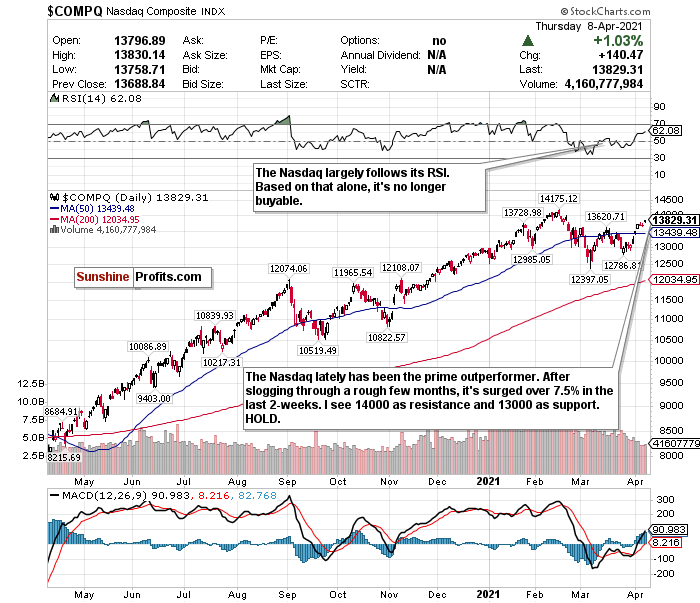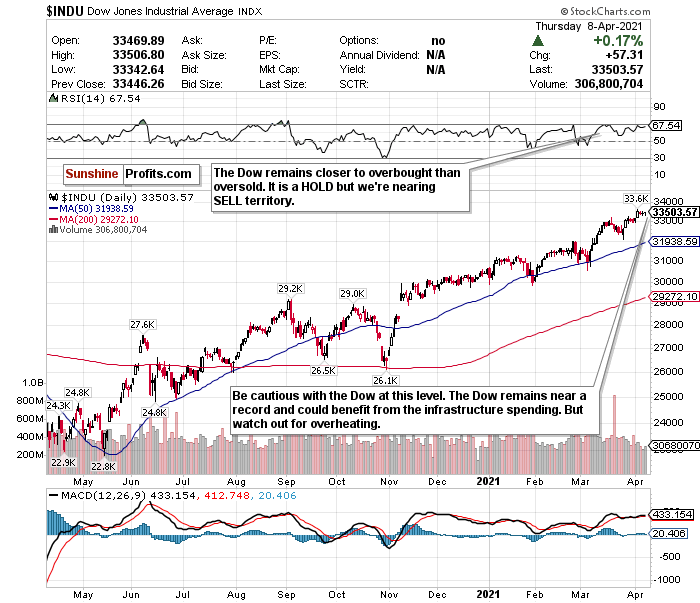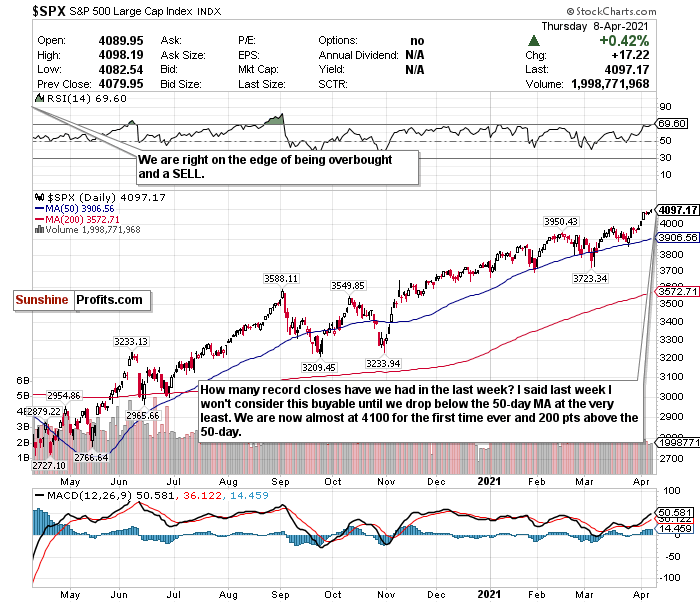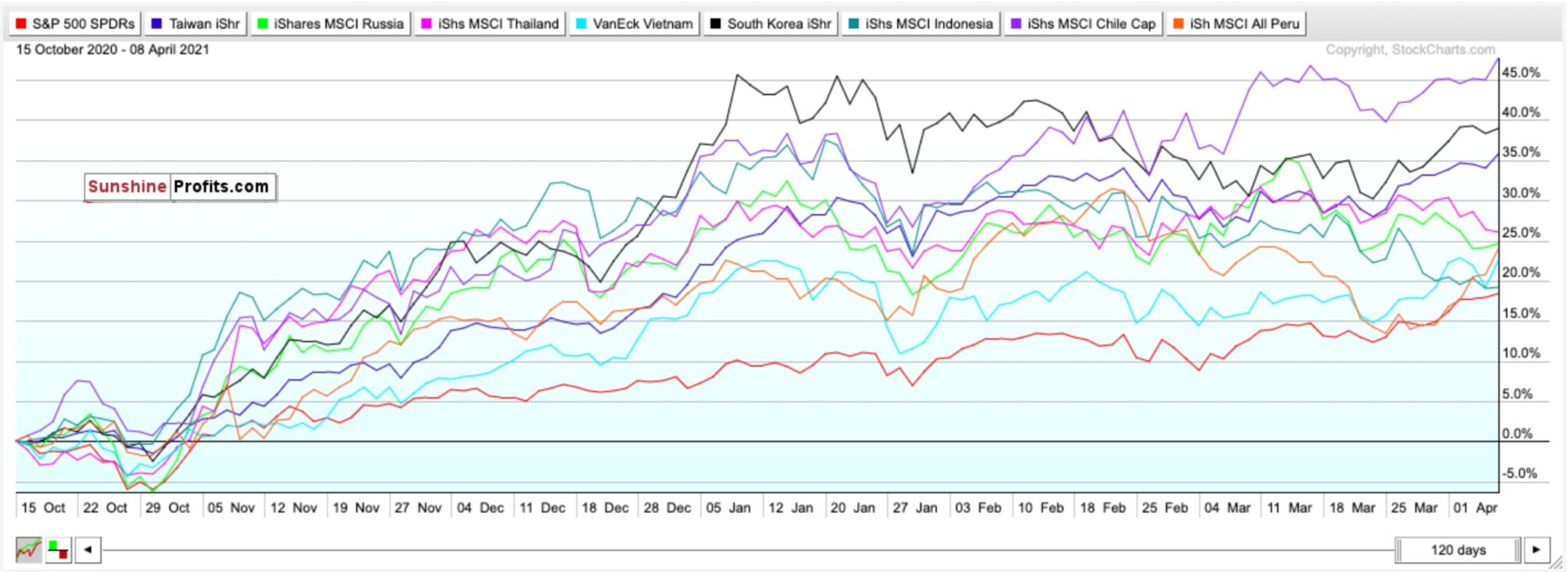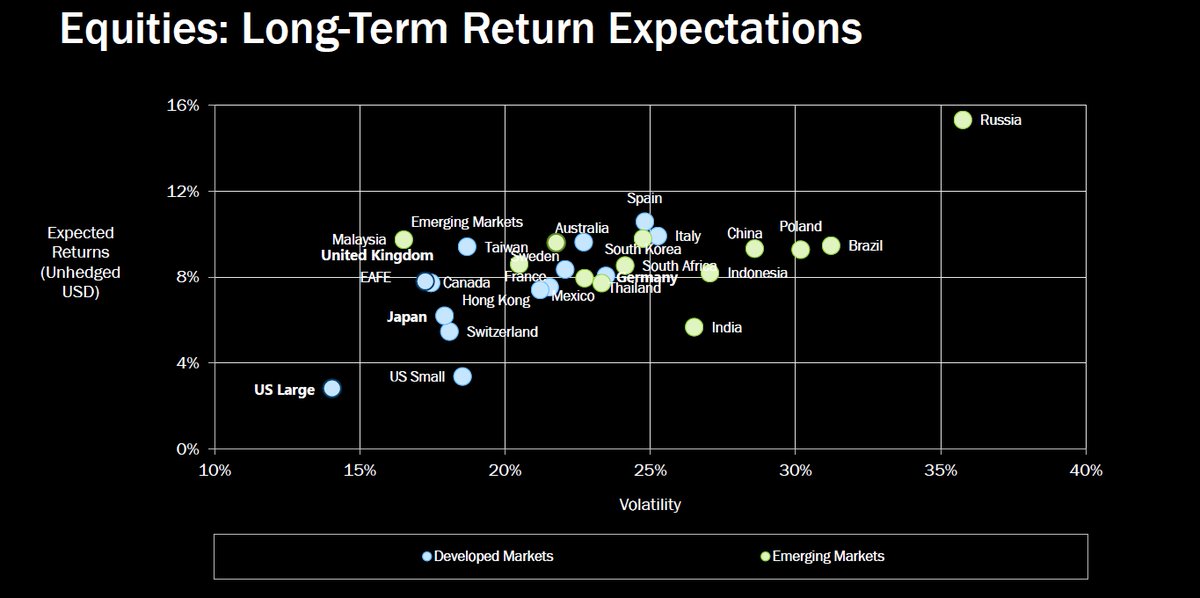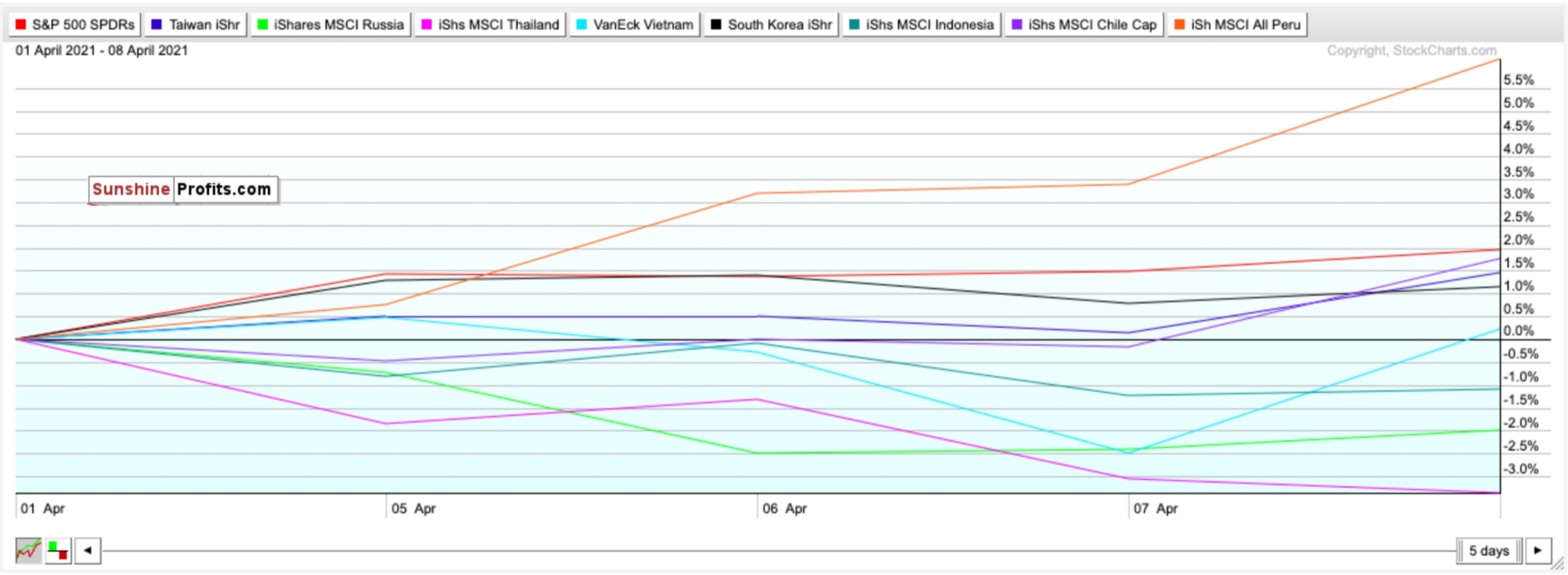In keeping with its historical performance, April has started off white-hot. We ended March, and Q1 for that matter, with more questions than answers.
But April 2021 started with a blowout jobs report, and the indices haven't looked back since. Right now, the S&P 500 is at yet another record, the Dow is just about at a record, and we've seen a furious comeback for Big Tech and growth stocks.
The sentiment is certainly better now than it was just a couple of weeks ago. However, I implore you to remember that every month in 2021 thus far has started off hot and saw a pullback/volatility occur in the second half of the month.
Think about it. In January, we had the GameStop trade spooking investors. In February and March, we had surging bond yields, inflation fears, or Jay Powell comments that rubbed people the wrong way. These concerns won't just disappear because we want them to. If we could make things magically disappear, COVID would've been over yesterday.
But, as I mentioned before, April historically is a strong month for stocks. According to Ryan Detrick, chief market strategist at LPL Financial, "Other than my Cincinnati Bengals breaking my heart, few things are more consistent than stocks higher in April."
During April, the S&P 500 has gained in 14 of the past 15 years. April has also been the strongest month for stocks over the past 20 years.
The market concerns, though, are still intact. We still have to worry about inflation, bond yields, and stocks peaking. According to Binky Chadha, Deutsche Bank's chief U.S. equity strategist, we could see a significant pullback between 6% and 10% over the next three months.
Another thing I'm a bit concerned about is the $2 trillion infrastructure plan. While this is great for America's crumbling infrastructure, do we really need to spend any more trillions?
Plus, how do you think this will be paid for? Hiking taxes- namely corporate taxes. Those gains that high growth stocks saw after Trump cut corporate taxes in 2017 could very well go away. While President Biden has indicated a willingness to negotiate his 28% corporate tax proposal, it's still a tax hike.
My goal for these updates is to educate you, give you ideas, and help you manage money like I did when I was pressing the buy and sell buttons for $600+ million in assets. I left that career to pursue one to help people who needed help instead of the ultra-high net worth.
With that said, to sum it up:
We're hot right now.
However, we could see more volatility and more muted gains than what we've come to know over the last year.
April is historically strong, but please continue to monitor inflation, yields, and potential tax hikes. Be optimistic but realistic. A decline above ~20%, leading to a bear market, appears unlikely. Yet, we could eventually see a minor pullback by the summer, as Deutsche Bank said.
Hopefully, you find my insights enlightening. I welcome your thoughts and questions and wish you the best of luck.
Nasdaq- What a Comeback
Figure 1- Nasdaq Composite Index $COMP
I proudly bought the dip on the Nasdaq when I switched my call to a BUY on February 24. While the Nasdaq-tracking Invesco QQQ ETF (QQQ) is only up about 3.5% since then, it’s up over 7.5% since March 18.
Needless to say, if you bought tech’s dip, it worked out very well for you.
But, out of all the indices, the Nasdaq concerns me the most. I use the RSI as my primary Nasdaq guide, 13000 as my support level, and 14000 as my resistance level. Taking these factors into consideration, the Nasdaq is a firm HOLD right now. But we may be nearing SELL territory once again. I remain concerned about not only inflation and bond yields but the prospects of tax hikes.
This $2 trillion infrastructure plan, while needed, could be the final push to genuinely bring inflation back, for bond yields to accelerate even faster, and for tax hikes to come.
I also worry about IPOs and SPACs. A different IPO or SPAC enters the market on what seems to be an almost weekly basis now. It’s comparable to the dot-com bust, and I don’t like it one bit. If this trend continues, we could see oversupply in the market and a shortage in demand. That is terrible news for growth stocks.
I remain bullish on tech sectors like cloud computing, e-commerce, and fintech. Yet while this rally has been fun, I’m actually more concerned now than I was several weeks ago when the Nasdaq lagged.
So is the curse of being somewhat contrarian.
HOLD, and see what happens over subsequent sessions. Monitor the infrastructure bill, tax hikes, and IPO/SPAC market. Research emerging tech sectors and high-quality companies.
The Dow Jones- Still Almost Overbought
Figure 2- Dow Jones Industrial Average $INDU
The Dow Jones remains red hot in 2021, despite somewhat lagging the other indices in April. I don’t think we’re buyable right now. We’re right about at its record high with an RSI over 67.5.
That sounds closer to a SELL than a BUY for me. Although many analysts believe the index could end the year at 35,000 or higher, and the wheels are in motion for a furious rally, you could do better for a buyable entry point.
Having Dow exposure can be valuable. The index has many strong recovery cyclical plays that should benefit from what appears to be an economic recovery and reopening going even better than expected. The Dow could also be quite beneficial as a hedge against volatile growth stocks. You won’t see bond yields spooking this index as much.
But at this level, it’s probably better to HOLD, let it ride, and maybe even consider trimming some profits the next time we hit a record high.
From my end, I’d prefer to stay patient and vigilant.
My call on the Dow stays a HOLD.
For an ETF that aims to correlate with the Dow’s performance, the SPDR Dow Jones ETF (DIA) is a reliable option.
Next up for the S&P- 4000?
Figure 3- S&P 500 Large Cap Index $SPX
On the one hand, according to Sanford C. Bernstein strategists, the S&P 500 index could double by the end of the decade and reach 8,000.
Historically, we could really be at a strong entry point for the long-term too. Over two weeks ago, we marked the first anniversary of this bull market. Historically, S&P 500 bull markets since 1957 on average resulted in price gains of 179% and lasted an average of 5.8 years.
Because the S&P has risen just about 86.17% since March 23, 2020, if history tells us anything, we’re just getting started.
On the other hand, the S&P 500 continues shattering its record highs and is above 4000 for the first time in its history. It could also break 4100 as early as, I don’t know, today?
I don’t see this as a buyable index at the moment, and its streakiness and pace scare me. I’d instead prefer a dip below the 50-day moving average, but even that is a questionable buy level.
Right now, the S&P 500 is a complex index to call. As said in the intro, April is historically strong for the S&P. The signs, however, tell me it’s somewhere between a HOLD and SELL. It’s probably better to sit and monitor for now.
Consider this also. This index is about to get a heck of a lot more volatile. Tesla (TSLA) joined the index at the end of 2020, and Penn National Gaming (PENN) just followed suit. While this could make things a bit more exciting, it could also make things a bit more unpredictable.
Unless I see some sort of buy or sell signal for the S&P 500, I think we’ll keep playing this HOLD game. But we are nearing SELL.
HOLD for now, but be prepared to SELL if it skyrockets some more. For an ETF that attempts to directly correlate with the performance of the S&P 500, the S&P 500 SPDR ETF (SPY) is a great option.
Beware of Inflation
Everyone’s favorite topic. Not.
I’m not trying to scare anyone, but being realistic. We’re already experiencing inflation.
Food prices are the earliest sign. Global food prices rose for the 10th straight month and are at their highest levels since 2014. The price of vegetable oil also reached its highest level in almost a decade.
Gas prices had also skyrocketed by almost 25% from this point last year.
Commodity prices are also surging, and the cost of toilet paper, diapers, and more are set to surge by June.
If and when President Biden’s infrastructure spending bill passes, watch out.
Bond yields and inflation fears have replaced the virus as the most significant market mover by far. In fact, according to MarketWatch, this could be the “biggest inflation scare in 40 years.”
For now, inflation data has consistently come in tamer than expected. But the signs are there that it could get gruesome by summertime. We need some clarity- is inflation really coming back, or is all this fear overblown?
“The rich world has come to take low inflation for granted. Perhaps it shouldn’t.” -The Economist.
As hedges against inflation, consider rereading my REIT special from March 26.
Consider also BUYING the SPDR TIPS ETF (SPIP), the Invesco Optimum Yield Diversified Commodity Strategy No K-1 ETF (PDBC), and the iShares Cohen & Steers REIT ETF (ICF).
Mid-Term/Long-Term
Add Emerging Market Exposure- Period
Figure 5- SPY, EWT, ERUS, THD, VNM, EWY, EIDO, ECH, EPU comparison chart- Oct. 15, 2020-Present
Since October 15, 2020, the SPDR S&P 500 ETF (SPY) has gained around 18.45%.
Mind you, this is quite strong. The S&P 500 is almost at 4100 and at an all-time high. Yet, all of my top emerging market picks for 2021 have outperformed the SPY in that same timeframe. The only one that comes close is my Indonesia ETF pick (EIDO), which still outperformed the SPY by almost 0.7%.
Consider this too.
With inflation on the horizon, a surge in commodity prices combined with shifting demographics could send other emerging markets upwards long-term. Plus, with birth rates plummeting during the pandemic in developed markets, it could mean long-term upside for emerging markets.
PWC echoes this sentiment and believes that emerging markets (E7) could grow around twice as fast as advanced economies (G7) on average in the coming decades.
For 2021, the following are my BUYs for emerging markets and why:
iShares MSCI Taiwan ETF (EWT)- Developing country, with stable fundamentals, diverse and modern hi-tech economy, regional upside without China’s same geopolitical risks.
iShares MSCI Thailand ETF (THD)- Bloomberg’s top emerging market pick for 2021 thanks to abundant reserves and a high potential for portfolio inflows. Undervalued compared to other ETFs.
iShares MSCI Russia Capped ETF (ERUS)- Bloomberg’s second choice for the top emerging market in 2021 thanks to robust external accounts, a robust fiscal profile, and an undervalued currency. Red-hot commodity market, growing hi-tech and software market, increasing personal incomes. Russian equities may also have potential upside north of 35%.
Figure 6- Equities: Long-Term Return Expectations Developed Markets/Emerging Markets
VanEck Vectors Vietnam ETF Vietnam (VNM)-Turned itself into an economy with a stable credit rating, strong exports, and modest public debt relative to growth rates. PWC believes Vietnam could also be the fastest-growing economy globally. It could be a Top 20 economy by 2050.
iShares MSCI South Korea ETF (EWY)- South Korea has a booming economy, robust exports, and stable yet high growth potential. The ETF has been the top-performing emerging market ETF since March 23.
iShares MSCI Indonesia ETF (EIDO)- Largest economy in Southeast Asia with young demographics. The fourth most populous country in the world. It could be less risky than other emerging markets while simultaneously growing fast. It could also be a Top 5 economy by 2050.
iShares MSCI Chile ETF (ECH)- One of South America’s largest and most prosperous economies. An abundance of natural resources and minerals. World’s largest exporter of copper. Could boom thanks to electric vehicles and batteries because of lithium demand. It is the world’s largest lithium exporter and could have 25% of the world’s reserves.
iShares MSCI Peru ETF (EPU)- A smaller developing economy but has robust gold and copper reserves and rich mineral resources.
Let’s see how my emerging market picks have performed in April thus far.
Figure 7- SPY, EWT, ERUS, THD, VNM, EWY, EIDO, ECH, EPU comparison chart- April 1-Present
What a difference a month can make. Last month, Peru was the biggest laggard. This month, it’s by far the most prominent leader.
Peru, because of its mineral reserves, was rocked by volatile commodity prices last month. It was also dinged by some political turmoil and a very nasty COVID wave.
However, since April 1, the EPU ETF is up about 6.15%. You can thank the comeback in commodity prices for that. Because Peru has so many miners, it’s usually leveraged to the upside of precious metals.
Since April 1, copper and silver are up over 2.5%, while gold is up almost 1.75%.
Outside of the aforementioned country-specific ETFs, you can also BUY the iShares MSCI Emerging Index Fund (EEM) for broad exposure to Emerging Markets.
Summary
While I don’t foresee the same gains that we saw since March 23, 2020, 2021 should still be a solid year for stocks despite some choppy waters. The overall backdrop right now remains favorable for stocks.
I’m going to list once again the top lessons learned from a year ago, as eloquently written by Ethan Wolff-Mann of Yahoo! Finance.
- ‘Every crisis is the same’
- Panic can hurt a portfolio
- You genuinely don’t know what’s going to happen
- Rebalancing comes out as a huge winner
Learn these lessons from a year ago—play volatility to your advantage. Be cautious but not scared, and do not try to time the market.
Most importantly, though:
NEVER TRADE WITH EMOTIONS.
Outside of the Russell 2000, I don’t really think we’re buyable right now. If you do have exposure, though, it’s a great time to HOLD and let it ride. April is historically a strong month for stocks.
If we see volatility, and we very likely will if Deutsche Bank’s calls come true, it's a mistake to fearfully sit out or run for the hills. Over a year out from the market’s bottom, let’s see the returns you’d see if you bought ANY of these index-tracking ETFs on March 23, 2020, when it appeared the world was ending: Russell 2000 (IWM) up 126.38%. Nasdaq (QQQ) up 97.81%. S&P 500 (SPY) up 86.17%. Dow Jones (DIA) up 83.22%.
Nobody knows “where” the actual bottom is for stocks. However, in the long-term, markets always move higher and focus on the future rather than the present.
To sum up my calls:
I have BUY call for:
- The iShares Russell 2000 ETF (IWM)
I have HOLD calls for:
- The Invesco QQQ ETF (QQQ),
- the SPDR S&P ETF (SPY), and
- the SPDR Dow Jones ETF (DIA)
I also recommend selling or hedging the US Dollar and gaining exposure into emerging markets for the mid-term and long-term.
I have BUY calls on:
- The iShares MSCI Emerging Index Fund (EEM),
- the iShares MSCI Taiwan ETF (EWT),
- the iShares MSCI Thailand ETF (THD),
- the iShares MSCI Russia ETF (ERUS),
- the VanEck Vectors Vietnam ETF (VNM),
- the iShares MSCI South Korea ETF (EWY),
- the iShares MSCI Indonesia ETF (EIDO),
- the iShares MSCI Chile ETF (ECH),
- and the iShares MSCI Peru ETF (EPU)
Additionally, because inflation shows signs of returning, and I foresee it potentially worsening as early as Q3 or Q4 2021...
I have BUY calls on:
- The SPDR TIPS ETF (SPIP),
- the Invesco Optimum Yield Diversified Commodity Strategy No K-1 ETF (PDBC), and
- the iShares Cohen & Steers REIT ETF (ICF)
Thank you.
Matthew Levy, CFA
Stock Trading Strategist


